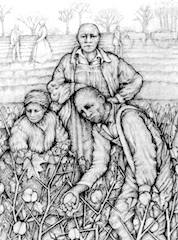|
J. William T. "Bill" Youngs, American Realities, Volume One:
Historical Episodes from First Settlements to the Civil War, Chapter Fourteen |
"Execrable Human Traffick, or The Affectionate Slaves,"
by George Morland courtesy of The Menil Collection |
14. A Slave’s Story
|
SummaryThe individual lives of most American slaves are lost to history. Diaries, letters, autobiographies, and oral histories allow us to explore the lives of a few, but we can seldom follow the lives of even the most articulate slaves back to Africa. The dark hold of the slave ship is an apt symbol for the obscurity from which the African seemingly emerges into American history. But in reality each African came from a vital world in which he or she lived before enslavement. The story of Adb Rahman Ibrahima is an exception to the pattern of uncertainty. We come to know him as an African and a Muslim before we know him as an enslaved person. As we follow his story, we gain a deeper appreciation for the African background of enslaved Americans, and we also gain a valuable perspective on the system of slavery itself and on those Americans who saw beyond it.
|
Author reads from the Text
Ibrahima was by now a colonel in his father’s army, and led a force of 2000 men, including 350 cavalry, intending to punish the Hebohs. The enemy fled and the Fulbe burned several of their villages. Satisfied with the campaign, Ibrahima sent the infantry home and followed more slowly with his cavalry. In the meantime the Hebohs had arranged themselves along the sides of a narrow pass through which the Fulbe would pass. Ibrahima’s men were leading their horses up a slope when gunshots rang out on all sides, killing and wounding many Fulbe. Ibrahima and his comrades were badly outnumbered. Hebohs armed with muskets surrounded him. They could easily have killed him, but they reversed their weapons, a sign that they wanted to take him prisoner. He struck one with his sword, but then a rifle barrel cracked across the back of his head and Ibrahima fell unconscious.
When he recovered, Ibrahima told his captors that he was the son of a king, who would gladly pay a ransom for his freedom. But the Hebohs refused to listen, even though Ibrahima’s clothing and ornaments did indicate his high station. They may have feared that a freed Fulbe colonel would make war against them in the future. Besides they had another way of making money off of Ibrahima and their other captives. In that region there were many Mandinka slatees, or slave traders, who bought prisoners to sell on the coast to the European slavers. The Hebohs sold Ibrahima to these men for two flasks of powder, several muskets, some tobacco, and two bottles of rum. Hearing of his son’s capture, Sori came and burned the Heboh lands in revenge, but by then the Mandinka had herded Ibrahima and fifty fellow Fulbe to the Gambia River. There they sold them to Capt. John Nevin, an Englishman, who loaded them aboard the slave ship Africa.
When he recovered, Ibrahima told his captors that he was the son of a king, who would gladly pay a ransom for his freedom. But the Hebohs refused to listen, even though Ibrahima’s clothing and ornaments did indicate his high station. They may have feared that a freed Fulbe colonel would make war against them in the future. Besides they had another way of making money off of Ibrahima and their other captives. In that region there were many Mandinka slatees, or slave traders, who bought prisoners to sell on the coast to the European slavers. The Hebohs sold Ibrahima to these men for two flasks of powder, several muskets, some tobacco, and two bottles of rum. Hearing of his son’s capture, Sori came and burned the Heboh lands in revenge, but by then the Mandinka had herded Ibrahima and fifty fellow Fulbe to the Gambia River. There they sold them to Capt. John Nevin, an Englishman, who loaded them aboard the slave ship Africa.

